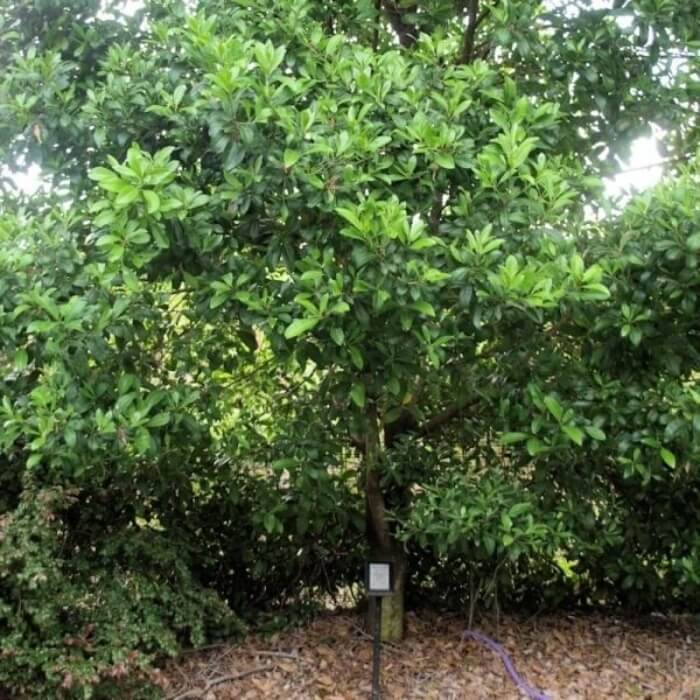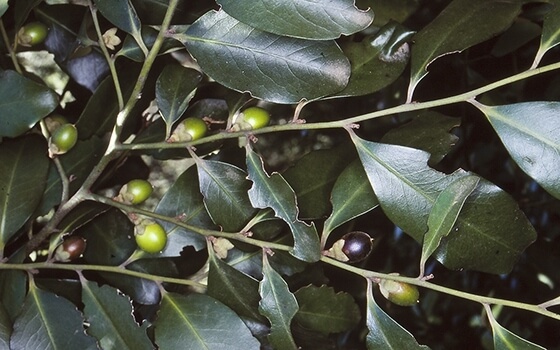Are you looking into growing black plum in your garden? Heavenly, divine, or noble. That is the meaning of Diospyros. A fruit bearing tree does often feel like a different kind of nature experience, one that is so rewarding each time you get the benefit of enjoying fruit from a tree that you have grown and nurtured.
In this black plum tree guide, I’ll go through propagation techniques from seed and cuttings, as well as care requirements for the tree which are rather simple.
More...

Source: Paten Park Native Nursery
Family: | Ebenaceae |
|---|---|
Genus: | Diospyros |
Species: | D. australis |
Common Names: | Black Plum, Yellow Persimmon, Grey Plum |
Origin: | Australian Native |
Location: | Outdoor |
Type: | Small tree or shrub |
Growth: | Up to 10 metres tall and 7 metres wide |
Sun requirements: | Full sun, part shade |
Foliage Colour: | Dark green, yellow green |
Flower Colour: | Cream, green |
Flowering: | October to December |
Edible Parts: | Fruit |
Maintenance level: | Low |
Poisonous for pets: | No |
Introducing Black Plum
Diospyros australis, commonly known as black plum or yellow persimmon, is a good looking tree that is sort of small to medium in size. The leaves are green on the top and then a yellow colour on the underside, with a yellow mid vein that is quite easy to spot.
This small tree is also often called black ebony, grey plum, or yellow persimmon. Since it’s a rainforest tree, it can tolerate heavy shade and likes to grow in moist soil. Wind and afternoon sun are not friends of Diospyros australis so keep this in mind when growing your own.
Back to the point about why I called the tree attractive. It produces small flowers that are a cream to yellow colour from October and they are self-pollinating. The female flowers are bigger than the male ones. After these come the edible shiny black fruit during autumn and winter.
Black Plum Fruit
The fruit is quite small, around 15 mm each, and starts off yellow and then turns black when it ripen. The best time to eat the fruit is when it’s black and soft. The fruit is wonderfully sweet. I have made many jellies, chutneys and jams with black plum fruit.
Other benefits of the yellow persimmon tree is that it’s fire retardant. If your home is in a bush area, planting one of these could offer some peace of mind.
How to Grow Black Plum
Diospyros australis is a native proudly Australian tree. You usually find it in south-east NSW and then up to Queensland. You can plant it as a feature tree or a hedge. So wonderfully versatile!
Yellow persimmon trees range in size from 4 to 10 metres high and 4 to 7 metres wide. They do grow slowly which makes them ideal to grow in a pot or keep them to shrub size if you prefer.

Source: Alchetron
Different Ways to Propagate Black Plum Tree
Black Plum Propagation Using Seeds
Ripe black plum fruit provides seed to propagate your own plant. There is a short window of viability to use the seed so aim to sow them with a 24 hour period after collection.
Each black plum fruit has one seed which is surrounded by purple flesh. Prep the seed by taking it out of its seed case and removing any remaining flesh. Any left behind can cause fungus and hijack the germination process.
Prepare a punnet or tray for planting with a suitable growing mix. Press each seed gently into the mixture and then cover it with a thin layer, pressing down gently with your fingers. Give the mix a sprinkling of water, making sure it stays moist but never soggy.
Pop the containers somewhere warm and protected with shade. It’s always exciting when the seedlings start to grow and develop leaves. At this point in the growth process, the little plants can do with a gentle misting of water daily.
When the second set of leaves arrives, it’s time to transplant the seedlings into pots. Fill up your chosen pots to about two thirds full of potting mix. Transplanting new seedlings can be a bit nerve racking as they are so delicate.
I like to use a spoon and aim to keep as much soil as possible around the new roots that have formed. Once the new plant is in the pot, fill it to the top with the soil and firm it down. Water well and often so that water goes down to the bottom of the container. The mix needs to stay damp between each watering session.
Propagating Yellow Persimmon from Cuttings
This small tree is a rainforest species so the best time to take cuttings is when the weather is warm. Semi-hardwood branches are ideal, taking an 8 cm cutting from the tip with a sharp and clean knife.
The lower cut should be just below a node. Remove the bottom leaves and keep a few younger leaves at the top. Using root hormones can help speed up the root growing process. Select a suitable well-draining planter that is deep enough for new roots to grow.
You can use a commercial propagation mix, or create your own with sand and perlite or vermiculite. Plant the cuttings and firm down the potting mixture to keep them secure.
Water the cuttings generously and then cover with a clear plastic bag to keep moisture in. This process helps with root development and the bag can be easily removed for watering. When you water, it should be enough to soak down all the way to the bottom of the container and a daily misting will work wonders too.
Keep the containers somewhere sheltered and shaded. If the black plum cuttings are going to eventually be planted in a spot with direct sun, place them in a sunny location a few days before transplanting so they have a chance to harden off.
How to Care for Your Black Plum Tree
Ideal Soil and Planting Location
Black plum trees enjoy full sun but can also tolerate heavy shade, giving you options in terms of where to plant them. Diospyros australis has 3 soil needs – it should be fertile, moist, and well-draining.
What Fertiliser to Use
Apply an organic fertiliser when planting black plum trees and then follow up during spring and summer every 6 weeks with a mineral complex fertiliser.
Watering Needs
Water a yellow persimmon tree as soon as it’s been planted and while it’s establishing. Once the tree or shrub is more mature it becomes hardy and water wise.
Pruning Black Plum Tree
Prune your black plum tree after harvesting fruit. This helps the tree stay in shape. Don’t take off too much new growth. This is the wood that produces fruit. Young plants can be pruned to maintain a certain shape for the tree.
For mature yellow persimmon trees, remove dry and damaged branches as needed. Do this in spring which helps the tree with branch growing.
Harvesting Black Plum Fruit

Source: Lucid Apps
Harvesting fruit from your own Diospyros australis brings great joy. The fruit is most enjoyable when it’s black and soft. Cut the fruit with a sharp knife or using hand pruners. Leave some of the stem still attached to the fruit.
The fruit bruises easily so don’t pack them on top of each other. Rather put them in a single layer on a tray. The black plum fruit prefers room temperature.
They taste the best eaten right away but if you need to store a few, pop them in the fridge in a plastic bag for a maximum of three days.
Diospyros australis Pests and Diseases
Scale
The best way to describe scale is that it looks like brown pimples growing on your tree. The scale lives off the sap of the branches and leaves. The easiest way to get rid of scale is picking the bugs off by hand or blasting them with a spray of water. Applying neem oil is also effective and organic.
Powdery mildew
Powdery mildew is easy to recognise. The spots on the black plum tree could be white to grey and look like powder. This disease will flourish in warm and dry weather. Home remedies to kick this disease are super simple.
Mix a tablespoon of baking soda and half a teaspoon of liquid dish soap with 3.8 litres of water. Fill a spray bottle and then apply well to your tree.
Leaf spot
Leaf spots can look different from plant to plant. The infection is sometimes round or angled, raised or sunken in, and can be smooth or more fringed at the edges. The colour also varies from yellow and green, to orange and red, to brown or black.
A plant or tree can even have a combination of different kinds of leaf spot. Smaller spots are the more recent infections. Treat your black plum tree with a sulphur spray or copper based fungicide.
Do this every week when you first notice the leaf spot. This will help contain the spread but doesn’t actually kill the leaf spot.
Black Plum Frequently Asked Questions

Source: Northern Beaches Herbarium
What is causing my black plum tree not to produce fruit?
This could be caused by a few things. Your yellow persimmon might not be getting enough sun. Move it to a spot with more sunlight. Change to a plant fertiliser that has less nitrogen which can also affect fruit production.
What is the earliest record of black plum as Australian bush tucker?
The Useful Native Plants of Australia book dating back to 1889 records that indigenous people of the Illawarra area called black plum "Booreerra" and used it as a food source.
Does black plum have any medicinal uses?
Both the fruit and leaves of Diospyros australis have health benefits. The black plum has been used to help maintain blood sugar levels, and to help with stomach pain and as a diuretic. It’s also high in vitamin C.
How many plants are included in the Diospyros genus?
There are more than 700 species of trees and shrubs that fall under the Diospyros genus. It is the only type of plant from the Ebenaceae family in Australia. More specifically, there are 15 species in Australia and you’ll find these in New South Wales, Queensland, Western Australia and the Northern Territory.
What does the name Diospyros australis mean?
Diospyros is Greek and means “heavenly”, “divine” or “noble”. Australis is Latin for “southern” referring to the part of the world where it’s found.
How long can a black plum tree live for?
On average they live around 60 years.
Wrapping Up Our Guide to Growing and Caring for Black Plum
Yellow persimmon was no doubt a great find when first discovered as a bush tucker. Its sweetness is comforting and moreish. The tree itself is easy to care for, being versatile in size and light requirements, and also being water wise and hardy once established.
I look forward to harvesting the small black fruit off my own tree, and coming up with new recipes to try out.
Published on December 5, 2023 by Lorri Hopkins
Last Updated on February 25, 2024




